[English] 日本語
 Yorodumi
Yorodumi- PDB-1ju5: Ternary complex of an Crk SH2 domain, Crk-derived phophopeptide, ... -
+ Open data
Open data
- Basic information
Basic information
| Entry | Database: PDB / ID: 1ju5 | ||||||
|---|---|---|---|---|---|---|---|
| Title | Ternary complex of an Crk SH2 domain, Crk-derived phophopeptide, and Abl SH3 domain by NMR spectroscopy | ||||||
 Components Components |
| ||||||
 Keywords Keywords | PROTEIN BINDING/TRANSFERASE / Crk / SH2 / Abl / SH3 / adaptor protein / phosphopeptide / PROTEIN BINDING-TRANSFERASE COMPLEX | ||||||
| Function / homology |  Function and homology information Function and homology informationPTK6 Regulates RHO GTPases, RAS GTPase and MAP kinases / ARMS-mediated activation / MET activates RAP1 and RAC1 / MET receptor recycling / response to hepatocyte growth factor / regulation of intracellular signal transduction / cellular response to endothelin / helper T cell diapedesis / cerebellar neuron development / response to cholecystokinin ...PTK6 Regulates RHO GTPases, RAS GTPase and MAP kinases / ARMS-mediated activation / MET activates RAP1 and RAC1 / MET receptor recycling / response to hepatocyte growth factor / regulation of intracellular signal transduction / cellular response to endothelin / helper T cell diapedesis / cerebellar neuron development / response to cholecystokinin / Downstream signal transduction / regulation of leukocyte migration / postsynaptic specialization assembly / protein phosphorylated amino acid binding / regulation of T cell migration / : / positive regulation of actin filament binding / p130Cas linkage to MAPK signaling for integrins / response to peptide / negative regulation of ubiquitin-protein transferase activity / protein localization to cytoplasmic microtubule plus-end / DNA conformation change / DN4 thymocyte differentiation / regulation of dendrite development / response to epinephrine / activation of protein kinase C activity / phospholipase C-inhibiting G protein-coupled receptor signaling pathway / podocyte apoptotic process / delta-catenin binding / Role of ABL in ROBO-SLIT signaling / transitional one stage B cell differentiation / regulation of postsynaptic specialization assembly / Regulation of signaling by CBL / regulation of modification of synaptic structure / nicotinate-nucleotide adenylyltransferase activity / cerebellum morphogenesis / neuroepithelial cell differentiation / negative regulation of wound healing / B cell proliferation involved in immune response / positive regulation of extracellular matrix organization / positive regulation of Wnt signaling pathway, planar cell polarity pathway / Regulation of actin dynamics for phagocytic cup formation / microspike assembly / response to yeast / B-1 B cell homeostasis / neuropilin signaling pathway / neuropilin binding / positive regulation of skeletal muscle acetylcholine-gated channel clustering / bubble DNA binding / reelin-mediated signaling pathway / mitochondrial depolarization / regulation of cell motility / ARMS-mediated activation / MET receptor recycling / VEGFA-VEGFR2 Pathway / positive regulation of establishment of T cell polarity / activated T cell proliferation / negative regulation of cell motility / cellular response to dopamine / positive regulation of blood vessel branching / negative regulation of natural killer cell mediated cytotoxicity / proline-rich region binding / MET activates RAP1 and RAC1 / negative regulation of mitotic cell cycle / regulation of Cdc42 protein signal transduction / protein localization to membrane / mitogen-activated protein kinase binding / regulation of hematopoietic stem cell differentiation / syntaxin binding / alpha-beta T cell differentiation / positive regulation of dendrite development / positive regulation of cell migration involved in sprouting angiogenesis / regulation of GTPase activity / peptidyl-tyrosine autophosphorylation / regulation of axon extension / positive regulation of smooth muscle cell migration / regulation of T cell differentiation / positive regulation of peptidyl-tyrosine phosphorylation / negative regulation of cell-cell adhesion / HDR through Single Strand Annealing (SSA) / neuromuscular process controlling balance / Myogenesis / positive regulation of osteoblast proliferation / p130Cas linkage to MAPK signaling for integrins / enzyme-linked receptor protein signaling pathway / cellular response to insulin-like growth factor stimulus / platelet-derived growth factor receptor-beta signaling pathway / positive regulation of vasoconstriction / RUNX2 regulates osteoblast differentiation / regulation of cell adhesion mediated by integrin / establishment of cell polarity / Fc-gamma receptor signaling pathway involved in phagocytosis / dendrite development / vascular endothelial cell response to oscillatory fluid shear stress / regulation of endocytosis / Bergmann glial cell differentiation / positive regulation of Rac protein signal transduction / regulation of microtubule polymerization / negative regulation of long-term synaptic potentiation / myoblast proliferation Similarity search - Function | ||||||
| Biological species |  Homo sapiens (human) Homo sapiens (human) | ||||||
| Method | SOLUTION NMR / ARIA 1.0, CNS 1.0 | ||||||
 Authors Authors | Donaldson, L.W. / Pawson, T. / Kay, L.E. / Forman-Kay, J.D. | ||||||
 Citation Citation |  Journal: Proc.Natl.Acad.Sci.USA / Year: 2002 Journal: Proc.Natl.Acad.Sci.USA / Year: 2002Title: Structure of a regulatory complex involving the Abl SH3 domain, the Crk SH2 domain, and a Crk-derived phosphopeptide Authors: Donaldson, L.W. / Gish, G. / Pawson, T. / Kay, L.E. / Forman-Kay, J.D. | ||||||
| History |
|
- Structure visualization
Structure visualization
| Structure viewer | Molecule:  Molmil Molmil Jmol/JSmol Jmol/JSmol |
|---|
- Downloads & links
Downloads & links
- Download
Download
| PDBx/mmCIF format |  1ju5.cif.gz 1ju5.cif.gz | 68.8 KB | Display |  PDBx/mmCIF format PDBx/mmCIF format |
|---|---|---|---|---|
| PDB format |  pdb1ju5.ent.gz pdb1ju5.ent.gz | 50.5 KB | Display |  PDB format PDB format |
| PDBx/mmJSON format |  1ju5.json.gz 1ju5.json.gz | Tree view |  PDBx/mmJSON format PDBx/mmJSON format | |
| Others |  Other downloads Other downloads |
-Validation report
| Summary document |  1ju5_validation.pdf.gz 1ju5_validation.pdf.gz | 258 KB | Display |  wwPDB validaton report wwPDB validaton report |
|---|---|---|---|---|
| Full document |  1ju5_full_validation.pdf.gz 1ju5_full_validation.pdf.gz | 257.7 KB | Display | |
| Data in XML |  1ju5_validation.xml.gz 1ju5_validation.xml.gz | 6.4 KB | Display | |
| Data in CIF |  1ju5_validation.cif.gz 1ju5_validation.cif.gz | 7.8 KB | Display | |
| Arichive directory |  https://data.pdbj.org/pub/pdb/validation_reports/ju/1ju5 https://data.pdbj.org/pub/pdb/validation_reports/ju/1ju5 ftp://data.pdbj.org/pub/pdb/validation_reports/ju/1ju5 ftp://data.pdbj.org/pub/pdb/validation_reports/ju/1ju5 | HTTPS FTP |
-Related structure data
| Related structure data | |
|---|---|
| Similar structure data |
- Links
Links
- Assembly
Assembly
| Deposited unit | 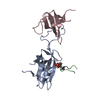
| |||||||||
|---|---|---|---|---|---|---|---|---|---|---|
| 1 |
| |||||||||
| NMR ensembles |
|
- Components
Components
| #1: Protein | Mass: 12142.571 Da / Num. of mol.: 1 / Fragment: Crk SH2 domain Source method: isolated from a genetically manipulated source Source: (gene. exp.)  Homo sapiens (human) / Plasmid: pGEX-2T / Species (production host): Escherichia coli / Production host: Homo sapiens (human) / Plasmid: pGEX-2T / Species (production host): Escherichia coli / Production host:  |
|---|---|
| #2: Protein/peptide | Mass: 1468.480 Da / Num. of mol.: 1 / Fragment: Crk phosphopeptide Source method: isolated from a genetically manipulated source Source: (gene. exp.)   |
| #3: Protein | Mass: 6764.461 Da / Num. of mol.: 1 / Fragment: Abl SH3 domain / Mutation: L122K Source method: isolated from a genetically manipulated source Source: (gene. exp.)  Homo sapiens (human) / Plasmid: pET15 / Species (production host): Escherichia coli / Production host: Homo sapiens (human) / Plasmid: pET15 / Species (production host): Escherichia coli / Production host:  |
| Has protein modification | Y |
-Experimental details
-Experiment
| Experiment | Method: SOLUTION NMR | ||||||||||||||||||||||||
|---|---|---|---|---|---|---|---|---|---|---|---|---|---|---|---|---|---|---|---|---|---|---|---|---|---|
| NMR experiment |
| ||||||||||||||||||||||||
| NMR details | Text: Intermolecular distance restraints were obtained from reverse half-filtered 2D- and 3D-NOESY spectra (300 ms mixing time) on sample in 99% D2O. Methyl prochiral assignments were made on a 10% ...Text: Intermolecular distance restraints were obtained from reverse half-filtered 2D- and 3D-NOESY spectra (300 ms mixing time) on sample in 99% D2O. Methyl prochiral assignments were made on a 10% 13C-labeled sample according to Neri et al (Biochemistry 28:7510; 1989). HACAN and CBCA(CO)N(CA)HA experiments were used to assign the proline residues in the Crk SH2 domain according to Kanelis et al (JBNMR 16:253; 2000) |
- Sample preparation
Sample preparation
| Details | Contents: 0.6-1.5mM Crk SH2 domain U-15N, 13C; 50mM sodium phosphate pH6.8, 0.02% sodium azide Solvent system: 90% H2O/10% D2O |
|---|---|
| Sample conditions | Ionic strength: 50mM sodium phosphate / pH: 6.8 / Pressure: ambient / Temperature: 303 K |
| Crystal grow | *PLUS Method: other / Details: NMR |
-NMR measurement
| Radiation | Protocol: SINGLE WAVELENGTH / Monochromatic (M) / Laue (L): M | ||||||||||||||||||||
|---|---|---|---|---|---|---|---|---|---|---|---|---|---|---|---|---|---|---|---|---|---|
| Radiation wavelength | Relative weight: 1 | ||||||||||||||||||||
| NMR spectrometer |
|
- Processing
Processing
| NMR software |
| ||||||||||||||||||||||||
|---|---|---|---|---|---|---|---|---|---|---|---|---|---|---|---|---|---|---|---|---|---|---|---|---|---|
| Refinement | Method: ARIA 1.0, CNS 1.0 / Software ordinal: 1 Details: This structure represents the lowest energy solution based on 2406 SH2 intramolecular restraints, 1628 SH3 intramolecular restraints, 37 SH2-SH3 intermolecular restraints, 64 SH2- ...Details: This structure represents the lowest energy solution based on 2406 SH2 intramolecular restraints, 1628 SH3 intramolecular restraints, 37 SH2-SH3 intermolecular restraints, 64 SH2-phosphopeptide intermolecular restraints, 50 hydrogen bonds, 54 direct 3J-HNHA couplings and 166 dihedral angle restraints from TALOS Residues 217-220 and 225-229 of the Crk phosphopeptide (Chain B) are disordered. As intermolecular contacts between the SH2 domain (Chain A) and the SH3 domain (Chain C) limited to amino acids 67-75 in DE-loop of the SH2 domain, there is no unique orientation between the SH2 domain and SH3 domain. | ||||||||||||||||||||||||
| NMR representative | Selection criteria: lowest energy | ||||||||||||||||||||||||
| NMR ensemble | Conformer selection criteria: structures with the lowest energy Conformers calculated total number: 40 / Conformers submitted total number: 1 |
 Movie
Movie Controller
Controller




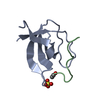
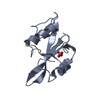


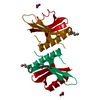
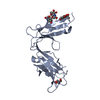
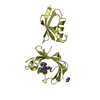
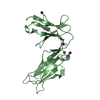

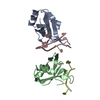




 PDBj
PDBj



















 HSQC
HSQC